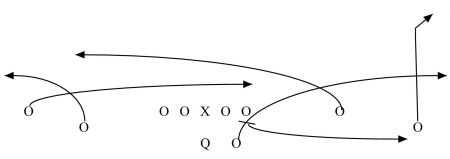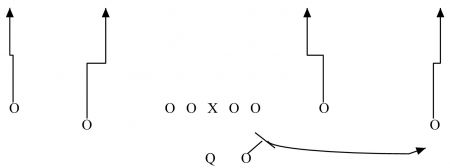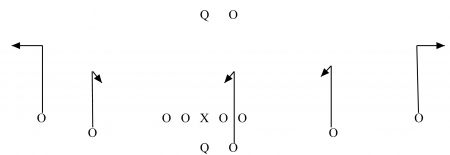BY Bill Ramseyer
The four most widely used passes of the Air Raid Spread Offense are the Shallow Cross, Mesh, 4 Verticals, and the Wide Receiver Screen. In addition to these basic plays, many times “tag words” are added to the call, changing one or more of the routes. Diagrams 1-12 show each of these plays, with variations, including each receiver’s route.

Diagram 1. “Shallow Cross”
The shallow cross is a staple of just about every Air Raid Spread Offense. “It is one of our more effective plays because of the options it presents for the quarterback,” said East Carolina’s Riley. “He can throw the ball to five different receivers spread across the field.”
Coaching points:
Vertical Routes – Outside release. Align inside the numbers. Must get back on top of the numbers.
“Shallow Cross” receiver – Sprint one-yard deep across the field. Run through the feet of the defensive linemen. Your route should go no deeper than three yards past the LOS. Let the sideline turn you upfield.
“Dig” receiver – The inside receiver opposite the shallow cross. Pattern is 10 yards deep. Sit down vs. zone, run through vs. man.
RB – Check release into the flat, or check flare.
QB – The shallow cross is the first read. Immediately look to the side of the field where shallow is moving to.

Diagram 2. “Shallow Cross” from Trips
The shallow cross with a trips formation also gives the quarterback five potential receivers but the field is narrowed down.
Coaching points:
“Shallow Cross” receiver – Cut the split in towards the ball.
Post receiver – Five-step post route. Take the middle of the field.

Diagram 3. “Mesh”
The ‘mesh’ route is also a fundamental part of most Air Raid offenses. Hal Mumme uses the mesh often during a game. “In the mesh the route receivers keep running vs. man coverage, and vs. zone coverage they stop and sit between the linebackers and find the open window between zones,” said Mumme.
Coaching points:
Corner receiver – Four-step corner. Take outside release of the defender.
Underneath mesh receiver – One step and go fast. Try and rub shoulders underneath other mesh. Sit down in first open window after mesh vs. zone. Run through vs. man coverage.
Deep mesh receiver – Set the depth at six yards. Sit down in the first open window after mesh vs. zone. Run through vs. man coverage.
Flat receiver – Aim for three yards out of bounds.
RB – Check release into the flat, or check flare.

Diagram 4. “Mesh” from Trips
For the mesh play in a trips formation, it is important for the underneath receiver to cut his split in towards the ball.
Coaching points:
Underneath mesh receiver – Cut the split in towards the ball.
Flat Receiver – Aim for three yards out of bounds.
RB – Check release into the flat, or check flare.

Diagram 5. Four Verticals
ECU’s Riley is a big proponent of the four verticals play and it’s a regular part of the Pirates offense. “You have four receivers going long but the quarterback also has the option of a flat pass to a running back,” said Riley.
Coaching point:
Inside Receiver – should occupy the middle of the field.

Diagram 6. Four Verticals from Trips
In the trips formation, the quarterback, again, has the option of a flat pass to a running back.

Diagram 7. Wide Receiver Screen
The wide receiver screen play is an important part of the McMurry offense. According to offensive coordinator Evan Burk it can be used in just about any situation. “The wide receiver screen is one of the least expected plays in our offense,” said Burk.
Coaching points:
Screen receivers – One step vertical, then come back across the LOS for the ball. Read the block and get upfield.
Screen blockers – Take a flat path over the screen. Be patient, and block the most dangerous defender. The defender will tell you where to go.
RB – Block/Fake run.

Diagram 8. Wide Receiver Screen from Trips
One advantage of the wide receiver screen from a trips formation is that it gives the receiver two blockers immediately in front of him.
Coaching Point:
Players concern themselves more with securing the double team block than they do with the corner. They feel that their wide outs vs. their corner is a win for them every time and they don’t want the safety or Sam LB making the tackle.
“The system teaches the offensive line to block ‘man’ leading to ‘zone’ vs. blitzes and twist stunts. The philosophy is ‘our
five have to beat their four’.” – Hal Mumme
Many high schools run the same combination of routes on both sides of the ball. Nyers of Plainfield High School, runs his spread from different formations. “Some teams emphasize formations, and run the same plays from a variety of looks,” he said. “The more formations and combinations, the harder it is for the defense to react.”
Whatever the variations, practicing helps any offense improve. “The key is repetition, and communication with the players,” said coach Parker of Pasquotank. “We use a number of formations, like many schools, but we try to get as many reps as possible each day. The coaches have to communicate with each player and make sure they understand their individual responsibility on every play.”
Here are four additional plays with various combination looks :

Diagram 9. “Shallow Cross”
This variation to the shallow cross is a staple part of our offense,” said Clayton George, Southlake Carroll’s offensive coordinator. “In this play, a running back and a wide receiver cross each other.
Coaching points:
Wide Outs – both go down and out toward the sidelines at 10 yards.
Running Back – Runs across the LOS and passes the wide out crossing the middle.
Dig Receiver – Inside receiver opposite the shallow cross receiver – Pattern is 12 yards deep.

Diagram 10. “Double Out”
Coaching points:
Play is based on a three-step drop.
Outside receivers – Run a 10-yard out pattern.
Inside receivers and running back all run hitches at six yards.

Diagram 11. “Hitch Seam”
Coaching Points:
Play is based on a three-step drop.
Outside receivers – run a hitch route at six yards.
Inside receivers – run a seam route, breaking inside after ten yards.

Diagram 12. “Slant Seam”
Coaching Points:
Play is based on a three-step drop.
Outside receivers – slant at 6ix yards.
Inside receivers – run a seam route, breaking inside after ten yards.
Whatever the method employed, the Air Raid definitely poses threats to every defense, especially those who usually face a two-back, run-first offense, with 20-25 passes, many of which are play-action passes. Easily overlooked are the wide line splits. This affects areas of responsibility, discouraging teams from having their linemen and linebackers stunt. The fast tempo, audible game is also difficult to exactly mimic with a scout team to adequately prepare the defense for what they will be facing.
Can the Air Raid work at all levels of the game? Assuming you have an intelligent, accurate quarterback, the answer is yes. These plays, courtesy of some of the masters of the Air Raid, will help get you started.